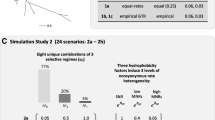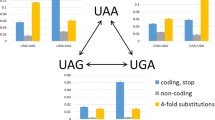Summary
We study the equilibrium in the use of synonymous codons by eukaryotic organisms and find five equations involving substitution rates that we believe embody the important implications of equilibrium for the process of silent substitution. We then combine these five equations with additional criteria to determine sets of substitution rates applicable to eukaryotic organisms. One method employs the equilibrium equations and a principle of maximum entropy to find the most uniform set of rates consistent with equilibrium. In a second method we combine the equilibrium equations with data on the man-mouse divergence to determine that set of rates that is most neutral yet consistent with both types of data (i.e., equilibrium and divergence data). Simulations show this second method to be quite reliable in spite of significant saturation in the substitution process. We find that when divergence data are included in the calculation of rates, even though these rates are chosen to be as neutral as possible, the strength of selection inferred from the nonuniformity of the rates is approximately doubled. Both sets of rates are applied to estimate the human-mouse divergence time based on several independent subsets of the divergence data consisting of the quartet, C- or T-ending duet, and A- or G-ending duet codon sets. Both rate sets produce patterns of divergence times that are shortest for the quartet data, intermediate for the CT-ending duets, and longest for the AG-ending duets. This indicates that rates of transitions in the duet-codon sets are significantly higher than those in the quartet-codon sets; this effect is especially marked for A→G, the rate of which in duets must be about double that in quartets.
Similar content being viewed by others
References
Dayhoff MO, Schwartz RM, Orcutt BC (1978) A model of evolutionary change in proteins. In: Dayhoff MO (ed) Atlas of protein sequence and structure. Vol 5, Suppl 3, Silver Spring, Maryland, pp 345–352
Efron B (1979) Computers and the theory of statistics: thinking the unthinkable. SIAM Rev 21:460–480
Efstratiadis A, Posakony J, Maniatis T, Lawn R, O'Connell C, Spritz R, DeRiel J, Forget B, Weissman S, Slightom J, Blechl A, Smithies O, Baralle F, Shoulders C, Proudfoot N (1980) The structure and evolution of the human β-globin gene family. Cell 21:653–668
Grantham C, Gautier C, Gouy M, Jacobzone M, Mercier R (1981) Codon catalog usage is a genome strategy modulated for gene expressivity. Nucl Acids Res 9:143–174
Hastings KEM, Emerson CP (1983) Codon usage in muscle and liver genes. J Mol Evol 19:214–218
Holmquist R (1983) Transitions and transversions in evolutionary descent: an approach to understanding. J Mol Evol 19:134–144
Holmquist R, Pearl D, Jukes T (1982) In: Goodman M (ed) Macromolecular sequences in systematic and evolutionary biology. Plenum, New York, pp 281–315
Holmquist, R, Cimino JB (1980) A general method for biological inference: illustrated by the estimation of gene nucleotide transition probabilities. Biosystems 12:1–22
Jaynes E (1978) Where do we stand on maximum entropy? In: Levin D and Tribus M (eds) The Maximum entropy formalism. MIT Press, Cambridge, Massachusetts, pp. 15–118
Jaynes E (1957a) Information theory and statistical mechanics. Phys Rev 106: 620–630
Jaynes E (1957b) Information theory and statistical mechanics II. Phys Rev 108:171–190
Jukes TH (1980) Silent nucleotide substitutions and the molecular evolutionary clock. Science 210:973–978
Kimura M (1981a) Estimation of evolutionary distance between homologous nucleotide sequences. Proc Natl Acad Sci USA 78:454–458
Kimura M (1981b) Possibility of extensive neutral evolution under stabilizing selection with special reference to nonrandom usage of synonymous codons. Proc Natl Acad Sci USA 78:5773–5777
Kimura M (1977) Preponderance of synonymous changes as evidence for the neutral theory of molecular evolution. Nature 267:275–276
Miyata, T, Hayoshida H, Kikuno R, Hasogawa M, Kobayashi M, Koike K (1982) Molecular clock of silent substitution: at least six-fold preponderance of silent changes in mitochondrial genes over those in nuclear genes. J Mol Evol 19:28–35
Miyata T, Hayoshida H (1981) Extraordinarily high evolutionary rate of pseudogenes: evidence for the presence of selective pressure against changes between synonymous codons. Proc Natl Acad Sci USA 78:5739–5743
Miyata T, Yasunaga T (1980) Molecular evolution of mRNA: a method for estimating evolutionary rates of synonymous and amino acid substitutions from homologous nucleotide sequences and its application. J Mol Evol 16:23–36
Miyata T, Yasunaga T, Nishida T (1980) Nucleotide sequence divergence and functional constraint in mRNA evolution. Proc Natl Acad Sci USA 77:7328–7332
Perler F, Efstratiadis A, Lomedico P, Gilbert W, Kolodner R, Dodgson J (1980) The evolution of genes: the chicken preproinsulin gene. Cell 20:555–566
Powell MJD (1977) Restart procedures for the conjugate gradient method. Math Prog 12:241–254
Sheppard HW, Gutman GA (1981) Allelic forms of ratk chain genes: evidence for strong selection at the level of nucleotide sequence. Proc Natl Acad Sci USA 78:7064–7068
Takahata N, Kimura M (1981) A model of evolutionary base substitutions and its application with special reference to rappid change of pseudogenes. Genetics 98:641–657
Wilson AC, Carlson SS, White TJ (1977) Biochemical evolution. Ann Rev Biochem 46:573–639
Author information
Authors and Affiliations
Rights and permissions
About this article
Cite this article
Wilbur, W.J. Codon equilibrium II: Its use in estimating silent-substitution rates. J Mol Evol 21, 182–191 (1985). https://doi.org/10.1007/BF02100092
Received:
Revised:
Issue Date:
DOI: https://doi.org/10.1007/BF02100092




